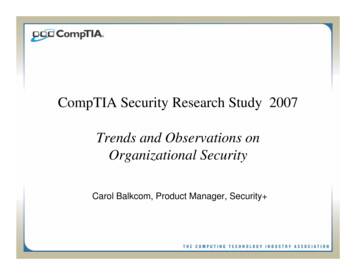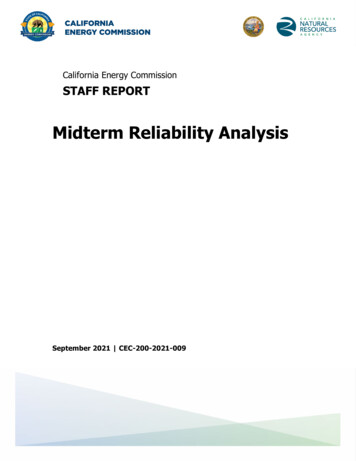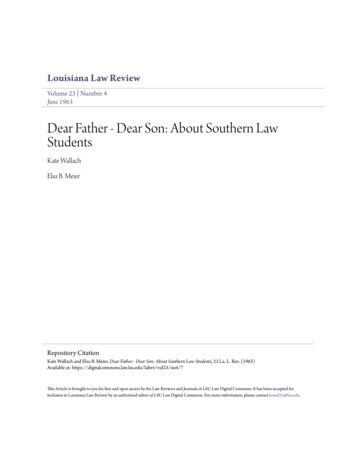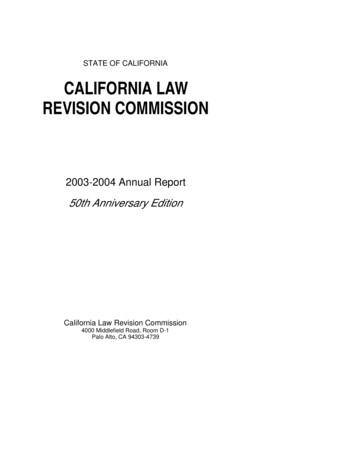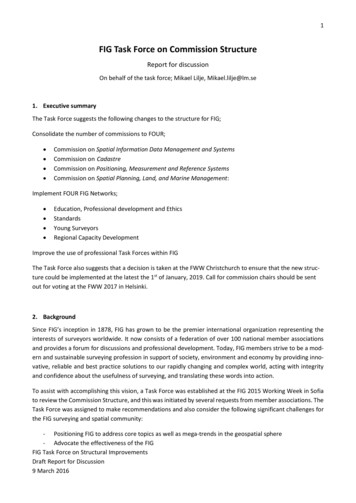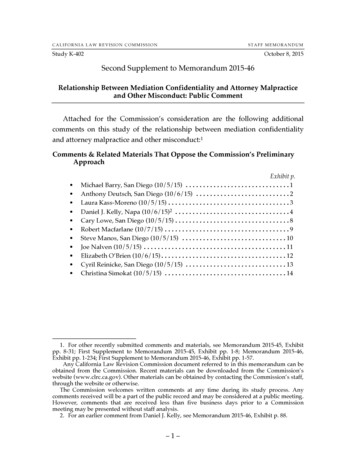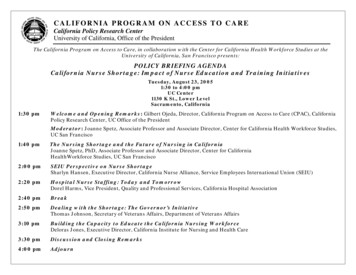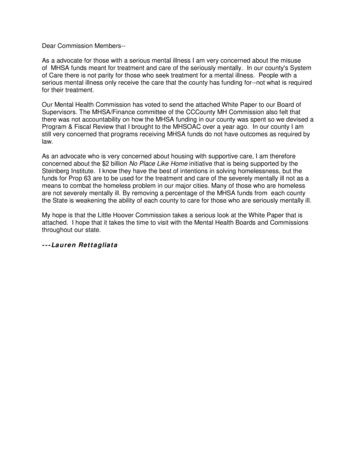
Transcription
Dear Commission Members-As a advocate for those with a serious mental illness I am very concerned about the misuseof MHSA funds meant for treatment and care of the seriously mentally. In our county's Systemof Care there is not parity for those who seek treatment for a mental illness. People with aserious mental illness only receive the care that the county has funding for--not what is requiredfor their treatment.Our Mental Health Commission has voted to send the attached White Paper to our Board ofSupervisors. The MHSA/Finance committee of the CCCounty MH Commission also felt thatthere was not accountability on how the MHSA funding in our county was spent so we devised aProgram & Fiscal Review that I brought to the MHSOAC over a year ago. In our county I amstill very concerned that programs receiving MHSA funds do not have outcomes as required bylaw.As an advocate who is very concerned about housing with supportive care, I am thereforeconcerned about the 2 billion No Place Like Home initiative that is being supported by theSteinberg Institute. I know they have the best of intentions in solving homelessness, but thefunds for Prop 63 are to be used for the treatment and care of the severely mentally ill not as ameans to combat the homeless problem in our major cities. Many of those who are homelessare not severely mentally ill. By removing a percentage of the MHSA funds from each countythe State is weakening the ability of each county to care for those who are seriously mentally ill.My hope is that the Little Hoover Commission takes a serious look at the White Paper that isattached. I hope that it takes the time to visit with the Mental Health Boards and Commissionsthroughout our state.---Lauren Rettagliata
Mental Health System and Budget CrisisIn Contra Costa County, FY/16/17Executive SummaryThis White Paper is a collaborative effort of the Contra Costa County Mental Health Commission(MHC) and Behavioral Health Services (BHS) with the support of the Behavioral Health CarePartnership (BHCP) to encourage discussion around the current crisis in the county public mentalhealth care system and deficits in the county mental health budget process that contribute to thiscrisis. The paper’s objective is to 1) focus attention on key symptoms of the crisis, and 2) inspirecollaborative, creative problem-solving and solutions that build on our many strengths whileovercoming budgeting challenges for the greatest impact on the well-being of people with aserious mental illness. This paper is presented to the Board of Supervisors for considerationduring the current budget planning cycle for 2016-17 as well as future cycles as we strive toprovide the best mental health care possible for those most in need in Contra Costa County.Key points of this White Paper describe: The wake-up call of the crisis at Psychiatric Emergency Services (PES) that points to animpacted system that is unable to provide the right treatment at the right moment in timeand is therefore struggling to truly meet the needs of people with a serious mental illness; The compromised ability of the Adult clinics and Child/Adolescent clinics to meet the needsof patients due to understaffing as evidenced by three to four month wait times and amigration of patients in crisis to PES for intervention that is not meant to be a stand-in fortreatment; The adverse lack of support for families, who are so critical to diagnosis, support andtreatment, due to the absence of Family Partner positions in the Children/Adolescentclinics and unfilled positions in the adult clinics; The deficit of treatment capacity for children and adolescents due to the lack of in-patientand residential beds (lack of contracts), an insufficient number of clinics, and understaffing,and the resulting increase in the number of children presenting at PES, cases of childrenstaying at PES for multiple weeks and months, and cases of children placed in treatment farfrom home and their families; The underlying theme of inadequate staffing levels due to the inability of treatmentfacilities to attract and keep high quality psychiatrists and nurses because of uncompetitive compensation and such practices as the closing of lists; and The underlying theme of dedicated, quality staff struggling to offer excellent care butundercut by budgets that are generated by a formulaic, top down process rather than aprocess that builds up a budget from program needs.In considering these challenges, perhaps the most critical step in solving our county’s mentalhealth crisis is to allocate funding in a way that meets patient needs at every level along thecontinuum of care. With program needs driving the budgeting process, we will create fiscal andhuman savings through our ability to treat illness before it enters the crisis state.
Taking a Close LookIn accordance with our state mandated duties outlined in WIC 5604.2, the Contra Costa CountyMental Health Commission has performed due diligence in reviewing the traditional budgetprocess for the Mental Health system. Through our committee work, site visits and collaborativeefforts we have studied fiscal documents, outcome based data and received testimony fromconsumers, families and providers. We have also read numerous reports, articles and studies onthe complexity of financing the California mental health system. Based on this collective learning,the Contra Costa County Mental Health Commission requests that the Board of Supervisorsrethink the traditional budget process for the public mental health system of Contra Costa Countyand recognize the existing system crisis.The Crisis at Psychiatric Emergency Services: A Wake-up CallOver the last decade, even with the additional prevention/intervention and full servicepartnership funding through the MHSA funding stream, there has been a dramatic rise in thenumber of patients accessing Psychiatric Emergency Services (PES). This is ground zero for crisisand the Contra Costa County behavioral health system barometer. It has reached a breaking point.The average number of patients being seen in PES now averages nine hundred per month. Thisincludes one hundred to one hundred and fifty children and adolescents per month. The PESphysical plant is designed for fourteen to twenty patients; however, it routinely holds double thisamount -- thirty to forty patients. This number had already sharply increased before theAffordable Care Act became operational and has not subsided with integrated services in severalof our county health and mental health centers. While there was hope that the Miller WellnessCenter would relieve the stress on PES, this has not occurred.Behavioral Health Administration points out the pressing need for access to key outpatientservices that are critical for discharge planning from both PES and the inpatient unit of thehospital (4C). These services include active case management, adult mobile response teams, dropin services (e.g. a sobering center), and dual diagnosis treatment. It is essential to expand capacityfor moderate to severely impaired mentally ill patients in behavioral health clinics while at thesame time increasing psychiatric support for primary care providers so that stable patients in thebehavioral health clinics may be transitioned to primary care providers.The Impact of Chronic UnderstaffingEach of the Children and Adult Specialty Mental Health Clinics are understaffed. The East clinic, forexample, is operating with a deficit of three psychiatrists. At the adult clinics, a patient seekingpsychiatric services may have “rapid access” to having a file opened, but the intake including thepsychiatric evaluation and necessary treatment is delayed for two to four months. Children areseen for an intake appointment within ten days, but it may take two to three months for an initialpsychiatry appointment. Patients have no other option but to access PES or the Miller WellnessCenter. In order to provide needed care and prevent unnecessary hospitalizations, the clinicsmust maintain sufficient staffing levels. This is the first step in fighting the firestorm of over 900patients that request treatment at PES each month.This chronic understaffing is not a human resource problem. It is a failure to think creatively andto raise the level of pay to attract quality psychiatrists. We need to review the entire compensationpacket for this pivotal position to see if we are aligned with other Bay Area counties. If not, weneed to make competitive compensation a top priority.2
Miller Wellness: Filling In For ClinicsThe Miller Wellness Center Behavioral Health was intended as a Mental Health Urgent Care forpatients with mild to moderate mental health conditions for up to 60 days, and a possiblepreventative service for voluntary-only severely mentally ill or severely emotional disturbedpatients presenting at PES. It is not a specialty mental health clinic, and it cannot replace thepsychiatric evaluations that are deemed medically necessary for disabled, severely mentally illpatients. Due to the markedly reduced access to mental health services through the county clinics,Miller Wellness Center has become the substitute for the behavioral health clinics, serving themoderate to severely impaired mentally ill population for substantially longer than the originallyintended sixty days.Providing For Family SupportProviding adequate support for families of both children and adults can also help prevent theavalanche of patients now being seen at PES. The Family Partner positions must be fully funded ineach Children’s Clinic and the Family Service Coordinator positions that have remained unfilledfor five years must be filled in each of the Adult Clinics. These positions ensure that the families ofseriously mentally patients can be educated to give vital information to health care professionals.They also support continuity of community-based and home care. These front line positions areessential and have remained unfilled for years, leading to crisis management in higher, moreexpensive levels of care.Caring For Our ChildrenSince the AB 3632 mandate was suspended in 2011, severely emotionally disturbed children havebeen known to spend more than the statutorily allowed twenty three hours at PES waitinghospitalization or residential placement. Some children have spent months in PES awaiting aninpatient or residential placement. This puts additional stress on the patient and the staff. Whilethis is a statewide and national problem, we have a legal and moral obligation to ensure thedevelopment of appropriate in-patient resources and facilities. Currently, freestanding hospitalsare able to deny admittance to our most difficult young patients. Appropriate contracts need to bein place for high risk, difficult-to-place youth. The children’s mental health clinics must be restoredto the previous staffing levels of 2008. All front line positions should be filled, especiallypsychiatrists, nurses, and clinicians in order to alleviate the crisis. The Behavioral HealthAdministration also sees a great need for additional night and weekend clinics to augment theMiller Wellness Center and PES.The county needs to work closely with First Hope to make a First Break program available forchildren and youths who are experiencing the initial effects of psychosis. This is one example ofwhy it is essential to keep the “lists” open for hiring mental health specialists. Closing the list (asmentioned in the CAO handout on the Budget) prevents our clinics and hospital from acquiring thebest and the brightest new graduates in the fields of Psychiatry and Psychology. Creativesolutions such as internship programs with UC Davis and UCSF should be explored.Housing That HealsThe number of persons with a serious mental illness who are homeless and in county shelters isrising. All MHSA-funded supportive housing for those with a serious mental illness is at capacityand our in-patient psychiatric unit is full. There is tremendous unmet need for mental healthresidential treatment and long-term supportive housing, yet we are holding millions of dollars inunspent MHSA funds.3
More alternative treatment residential programs that lead to permanent, service-enriched housingmodels for people with a serious mental illness need to be explored, invested in, and implemented.Although “Housing First” was been adopted and promoted in our county several years ago, itcannot be effectively implemented without an adequate inventory of housing that is embeddedwith services that support consumers in developing skills to maintain their health and recovery. Atrue supportive housing model that includes teaching many consumers “direct skills” to maintaintheir health and recovery will prevent many high costs and reduce out-of-county placements.The housing needs of our consumers and families present many challenges that follow acontinuum from least restrictive to locked settings. Some see a need for more permanentsupportive and shared housing; others see a need for more shelters; while others are calling formore residential alternative treatment settings. There may be a need for all. Behavioral Health iscommitted to working with stakeholders to look at the whole picture and to define solutions to thehousing crisis, but planning meetings without action plans that are implemented remain only adream, not a needed solution.Creating a well-planned system for moving those with serious mental illness into the mostappropriate housing model will be a savings to the county. There will always be a need for lockedfacilities and skilled nursing facilities, but many patients could be more effectively served inalternative residential treatment programs and permanent supportive housing in this county.Permanent supportive housing will also give those living in shelters or transitional housing abetter path to optimal health. The county budget process must take a deep look at the fundingstreams that could make supportive housing a reality for people with serious mental illnesses.Funding Our SolutionsAlthough the above problems can be classified as “Quality of Care” or “Human Resource” issues, inreality they are “Budget” problems. They are local, state and national problems that we musttackle. They are not problems without solutions. Creativity and collaboration must be employedto use the various braided budget streams to protect and augment resources. Budgets must bebuilt based on program needs defined by people in the trenches rather than generated by aformulaic, top down process that is not always sensitive to the harsh realities on the ground.California has more mental health funding available than any other state in the union. Yet we donot demonstrate the best outcomes for our communities. While Contra Costa County has the toolsto create the best mental health system in the state, we must break through bureaucratic andbudgeting barriers in order to maximize our strengths. Funding must be allocated to meet patientneeds at the clinic level and every level along the continuum of care. This will create fiscal andhuman savings because we will be treating illness before it enters the critical or crisis state. Wehave learned to do this routinely with heart disease, lung disease, cancer, and diabetes. Why notwith the brain disease of mental illness?Respectfully submitted,Contra Costa County Mental Health CommissionIn collaboration with the Behavioral Health AdministrationAnd in consultation with the Behavioral Health Care PartnershipApril, 20164
APPENDIXSource Reports and Articles to ConsiderFinancing mental health ia-Community-Mental-Health-Programs.pdfA report prepared in 1981 (still relevant today) at a time when legislature was aware ofthe underfunding of community mental health and asked the community to develop a reportestimating how big the underfunding was and what would be needed.http://www.mhac.org/pdf/mh funding.pdfUnderfunded from the es/default/files/storyflipbooks/funding publicmental health/files/dmh funding.pdfwww.chcf.org/./download.aspx?id.Public Mental Health Delivery and Financing in CaliforniaThe lack of hospital beds; impact on Psychiatric Emergency elmed/Content?oid age/documents/the shortage of publichospital UID EB5182F5-3FB6-4E50-A0B8-3E20501364F7&rememberme 1&ts 131116/magazine/311169992The rapid rise of Psychiatric Emergency e in Latino youth hospitalizations; comparative numbers for other youth tric-hospitalizations/A special “thank you” to Kristine Girard, M.D.Chief Psychiatrist, Contra Costa Regional Medical CenterFor her contribution of several excellent resources5
Attachment 1 – Program and Fiscal Review Report TemplateMental Health Services Act (MHSA)Program and Fiscal ReviewI.Date of On-site Review:Date of Exit Meeting:II.Review Team:III.Name of Program/Plan Element:IV.Program Description.V.Purpose of Review.Contra Costa Mental Health is committed toevaluating the effective use of funds provided by the Mental Health Services Act.Toward this end a comprehensive program and fiscal review was conducted ofthe above program/plan element. The results of this review are contained herein,and will assist in a) improving the services and supports that are provided, b)more efficiently support the County’s MHSA Three Year Program andExpenditure Plan, and c) ensure compliance with statute, regulations and policy.In the spirit of continually working toward better services we most appreciate thisopportunity to collaborate together with the staff and clients participating in thisprogram/plan element in order to review past and current efforts, and plan for thefuture.VI.Summary of Findings.VII.Review Results.The review covered the following areas:1. Deliver services according to the values of the Mental Health Services Act(California Code of Regulations Section 3320 – MHSA General Standards).Does the program/plan element collaborate with the community, provide anintegrated service experience, promote wellness, recovery and resilience, beculturally competent, and be client and family driven.Method. Consumer, family member and service provider interviews andconsumer surveys.Results.Discussion.1
Attachment 1 – Program and Fiscal Review Report Template2. Serve the agreed upon target population. For Community Services andSupports, does the program serve adults with a serious mental illness or childrenor youth with a serious emotional disturbance. For Prevention and EarlyIntervention, does the program prevent the development of a serious mentalillness or serious emotional disturbance, and help reduce disparities in service.Does the program serve the agreed upon target population (such as age group,underserved community).Method. Compare the program description and/or service work plan with arandom sampling of client charts or case files.Results.Discussion.3. Provide the services for which funding was allocated. Does the programprovide the number and type of services that have been agreed upon.Method. Compare the service work plan or program service goals with regularreports and match with case file reviews and client/family member and serviceprovider interviews.Results.Discussion.4. Meet the needs of the community and/or population. Is the program or planelement meeting the needs of the population/community for which it wasdesigned. Has the program or plan element been authorized by the Board ofSupervisors as a result of a community program planning process. Is theprogram or plan element consistent with the MHSA Three Year Program andExpenditure Plan.Method. Research the authorization and inception of the program for adherenceto the Community Program Planning Process. Match the service work plan orprogram description with the Three Year Plan. Compare with consumer/familymember and service provider interviews. Review client surveys.Results.Discussion.5. Serve the number of individuals that have been agreed upon. Has theprogram been serving the number of individuals specified in the programdescription/service work plan, and how has the number served been trending thelast three years.Method. Match program description/service work plan with history of monthlyreports and verify with supporting documentation, such as logs, sign-in sheetsand case files.2
Attachment 1 – Program and Fiscal Review Report TemplateResults.Discussion.6. Achieve the outcomes that have been agreed upon. Is the program meetingthe agreed upon outcome goals, and how has the outcomes been trending.Method. Match outcomes reported for the last three years with outcomesprojected in the program description/service work plan, and verify validity ofoutcome with supporting documentation, such as case files or charts. Outcomedomains include, as appropriate, incidence of restriction, incidence of psychiatriccrisis, meaningful activity, psychiatric symptoms, consumer satisfaction/quality oflife, and cost effectiveness. Analyze the level of success by the context, asappropriate, of pre- and post-intervention, control versus experimental group,year-to-year difference, comparison with similar programs, or measurement to agenerally accepted standard.Results.Discussion.7. Quality Assurance. How does the program/plan element assure quality ofservice provision.Method. Review and report on results of participation in County’s utilizationreview, quality management incidence reporting, and other appropriate means ofquality of service review.Results.Discussion.8. Ensure protection of confidentiality of protected health information. Whatprotocols are in place to comply with the Health Insurance Portability andAccountability Assurance (HIPAA) Act, and how well does staff comply with theprotocol.Method. Match the HIPAA Business Associate service contract attachment withthe observed implementation of the program/plan element’s implementation of aprotocol for safeguarding protected patient health information.Results.Discussion.9. Staffing sufficient for the program. Is there sufficient dedicated staff to deliverthe services, evaluate the program for sufficiency of outcomes and continuousquality improvement, and provide sufficient administrative support.Method. Match history of program response with organization chart, staffinterviews and duty statements.3
Attachment 1 – Program and Fiscal Review Report TemplateResults.Discussion.10. Annual independent fiscal audit. Did the organization have an annualindependent fiscal audit performed and did the independent auditors issue anyfindings.Method. Obtain and review audited financial statements. If applicable, discussany findings or concerns identified by auditors with fiscal manager.Results.Discussion.11. Fiscal resources sufficient to deliver and sustain the services. Doesorganization have diversified revenue sources, adequate cash flow, sufficientcoverage of liabilities, and qualified fiscal management to sustain program orplan element.Method. Review audited financial statements (contractor) or financial reports(county). Review Board of Directors meeting minutes (contractor). Interviewfiscal manager of program or plan element.Results.Discussion.12. Oversight sufficient to comply with generally accepted accountingprinciples. Does organization have appropriate qualified staff and internalcontrols to assure compliance with generally accepted accounting principles.Method. Interview with fiscal manager of program or plan element.Results.Discussion.13. Documentation sufficient to support invoices. Do the organization’s financialreports support monthly invoices charged to the program or plan element andensure no duplicate billing.Method. Reconcile financial system with monthly invoices. Interview fiscalmanager of program or plan element.Results.Discussion.14. Documentation sufficient to support allowable expenditures. Doesorganization have sufficient supporting documentation (payroll records andtimecards, receipts, allocation bases/statistics) to support program personnel andoperating expenditures charged to the program or plan element.4
Attachment 1 – Program and Fiscal Review Report TemplateMethod. Match random sample of one month of supporting documentation foreach fiscal year (up to three years) for identification of personnel costs andoperating expenditures charged to the cost center (county) or invoiced to thecounty (contractor).Results.Discussion.15. Documentation sufficient to support expenditures invoiced in appropriatefiscal year. Do organization’s financial system year end closing entries supportexpenditures invoiced in appropriate fiscal year (i.e., fiscal year in whichexpenditures were incurred regardless of when cash flows).Method. Reconcile year end closing entries in financial system with invoices.Interview fiscal manager of program or plan element.Results.Discussion.16. Administrative costs sufficiently justified and appropriate to the total costof the program. Is the organization’s allocation of administrative/indirect coststo the program or plan element commensurate with the benefit received by theprogram or plan element.Method. Review methodology and statistics used to allocateadministrative/indirect costs. Interview fiscal manager of program or planelement.Results.Discussion.17. Insurance policies sufficient to comply with contract. Does the organizationhave insurance policies in effect that are consistent with the requirements of thecontract.Method. Review insurance policies.Results.Discussion.18. Effective communication between contract manager and contractor. Doboth the contract manager and contractor staff communicate routinely and clearlyregarding program activities, and any program or fiscal issues as they arise.Method. Interview contract manager and contractor staff.Results.Discussion.5
Attachment 1 – Program and Fiscal Review Report TemplateVIII.Summary of Results.IX.Findings for Further Attention.X.Next Review Date.XI.Appendices.Appendix A – Program Description/Service Work PlanAppendix B – Service Provider Budget (Contractor)Appendix C – Yearly External Fiscal Audit (Contractor)Appendix D – Organization ChartXII.Working Documents that Support Findings.Consumer ListingConsumer, Family Member SurveysConsumer, Family Member, Provider InterviewsCounty MHSA Monthly Financial ReportProgress Reports, OutcomesMonthly Invoices with Supporting Documentation (Contractor)Indirect Cost Allocation Methodology/Plan (Contractor)Board of Directors’ Meeting Minutes (Contractor)Insurance Policies (Contractor)MHSA Three Year Plan and Update(s)6
Senate Housing Construction Plan Will Cost 3.9 Billion to Repay 2 BillionCampaign. Mental Illness FACTS –Family And Community True StoriesFor Immediate Release: Monday April 4, 2016 Contact: Rose King 916-768-8012; rking1@surewest.netFROM FACTS: COSTLY and UNLAWFUL SENATE HOUSING PLAN TO RAID PROP 63We Cannot Click Our Ruby Slippers and Do Away with Homelessness1. The California Senate has announced an initiative to tackle homelessness. There is a plannow called “ No Place Like Home” that creates a 2 billion bond to build between 10,00014,000 housing units for the homeless throughout the state. This sounds very commendable.Who doesn’t want to end homelessness—but there are serious flaws with this plan.2. It is securitized by MHSA funds. Californians voted for Prop 63 funds to be used only forthe treatment and care of people with serious mental illnesses—not to combat homelessness.Not all people who are homeless have a serious mental illness. Taking these funds to buildhomes for all homeless would be a misappropriation of these funds. An established AttorneyGeneral Opinion confirms how this plan violates MHSA provisions and voter intent.3. 130 million in MHSA funds would be taken each year to securitize this bond measure.Think about this—over the life of the 30 year bond that is securitized at 130 million a year,as the Darrell Steinberg Foundation has envisioned, the MHSA fund will be paying back 3.9billion to use 2 billion!4. The plan places decisions in the hands of a new layer of bureaucracy that decides whichcounties get to use the funds. Wouldn’t the wise approach allow each county to use its MHSAfunding to provide housing that fits its community’s needs? A new level of bureaucracy meansless money spent on direct treatment for serious mental illnesses.5. The Fair Housing Act of 1968 was meant to tackle homelessness and associated issues, and itfailed. “No Place Like Home” is this same well-intended, but failed idea, at the expense ofCalifornians denied essential treatment for serious mental illnesses.6. The plan is to award the new 2 billion in bond funds through a competitive grant process.All counties would be giving up their portion of the MHSA funds, but only some countieswould be receiving funds. Counties with good grant writing ability would be unfairlyfavored—and without regard to need. Some counties could pay into this for years andnever be awarded any funding or receive their fair share.Lauren Rettagliata, family member, Contra Costa Advocate, Email: rettagliata@sbcglobal.net
Right to Treatment campaign challenges “No Place Like Home”Contact: Rose King 916-768-8012; rking1@surewest.net Teresa Pasquini tcpasquini@gmail.comSenate “Housing First” Is Unlawful and Unfunded—State Must Fund Mental Health “Parity First”The Senate “housing first” plan is unaffordable and unlawful, according to Rose King, a co-author of Prop63, and local
In Contra Costa County, FY/16/17 Executive Summary This White Paper is a collaborative effort of the Contra Costa County Mental Health Commission (MHC) and Behavioral Health Services (BHS) with the support of the Behavioral Health Care Partnership (BHCP) to encourage discussion around the current crisis in the county public mental
